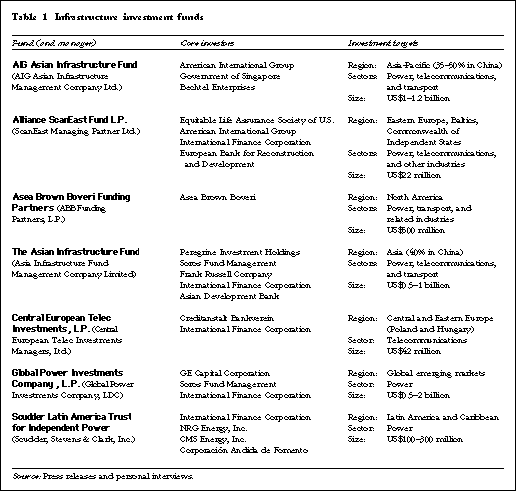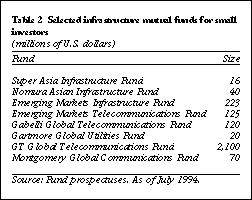![]()
|
Infrastructure Investment FundsAndrea Anayiotos
This Note discusses new methods for tapping international and local capital markets for long-term infrastructure funding, and it focuses in particular on the key characteristics of the equity funds—pooling risk and providing long-term capital to private entities. These key features are relevant to the design and implementation of infrastructure debt funds being considered for World Bank participation in such countries as China, Colombia, India, Jamaica, Mexico, Pakistan, Sri Lanka, and Thailand. Expanding private sector participation in infrastructureInfrastructure spending in developing countries is expected to exceed US$200 billion a year during the 1990s. Private investment now accounts for about 7 percent of the total, but its share is increasing and may double by the year 2000.1 Private sector participation has occurred through the privatization of existing assets and through new investment—using mainly limited-recourse or non-recourse financing schemes, including build-operate-transfer or build-operate-own arrangements. These BOT and BOO arrangements are financed mostly by sponsors, buyers' credits, loans from export-import (EXIM) and commercial banks, and multilateral agencies. However, new methods of tapping financial markets are being developed, including the establishment of equity funds. Local market finance has been limited in most developing countries, and significant funds are being sought from abroad in the form of direct and portfolio investments and bank loans. However, to sustain private investment in infrastructure over time, local capital market development will be necessary. To some extent this is already taking place. The International Finance Corporation's (IFC) Emerging Markets Database shows that the total capitalization of stock markets in developing countries grew from US$599 billion in 1989 to US$1,399 billion in 1993, with infrastructure stocks increasing from 3 percent to 22 percent of the total capitalization. In Malaysia, for example, YTL raised funding for two independent power projects from domestic pension funds. New ways of tapping capital marketsSome infrastructure firms in developing countries—those with an operating track record—have gained access to international capital markets through equity and bond issues. Compania de TŽlefonos de Chile and TŽlefonos de Mexico have issued equity in the form of American depositary receipts (ADRs) on the New York Stock Exchange.2 Bonds issued in the United States under rule 144a3 raised US$105 million for the Subic power plant (Philippines), which is 50 percent owned by Enron, a major U.S. company. Revenue bonds were also issued under rule 144a to raise funds for the Mexico City-Toluca Toll Road. The AES Corporation (United States) and Hopewell Holdings Ltd. (Hong Kong) have set up subsidiaries that have raised equity through public offerings to invest in the Asian power markets. General Electric Capital Corporation (a subsidiary of GE Corporation) issues securities on U.S. and European markets and invests portions of the proceeds in projects throughout the world.
A number of equity funds have been established with the potential to raise approximately US$5 billion for investing in a portfolio of private infrastructure entities in developing countries (table 1). Similar funds exist in industrial countries; for example, the Energy Investors Fund (United States) invests in independent power projects in the United States, and the Infratil Fund invests in the deregulated infrastructure sectors of New Zealand.
In addition, there are a number of mutual funds that invest in the listed securities of infrastructure firms in various countries (table 2). Key characteristics of the equity fundsThe growing number of equity funds will channel equity, quasi-equity, and, in some cases, debt capital from institutional investors to power, telecommunications, and transport projects in Asia and Latin America. These funds allow investors, who might otherwise not invest in individual projects because of risks and costs associated with making efficiently sized investments in individual projects, to invest in diversified portfolios of infrastructure firms and projects. The funds will allow institutional investors to invest in the growth sectors of power and telecommunications in developing countries and to reap higher returns than through comparable investments in industrial countries.4
Reputable investment management companies and financiers are the sponsors and the driving force in the creation of these equity funds. The IFC played a key role in the creation of five funds--as a cosponsor and as an investor. The sponsors' business and government contacts have enhanced the marketability of these funds and may act as a catalyst for significant private flows of equity and debt capital to Asia and Latin America. In addition to providing capital, the funds will mobilize debt for their portfolio investments from EXIM banks and multilateral and financial institutions. These funds typically are set up as limited partnerships or trust companies, and public information concerning their operations is limited. The AIG fund, which had its first closing in May 1994, raised more than US$1 billion. The Asea Brown Boveri (ABB) fund raised US$100 million in 1993, and the Central European fund raised US$42 million in May 1994. The Scudder fund has made two investments recently, one in the 100-megawatt Mamonal power plant in Colombia and the other in the 60-megawatt Elcosa project in Honduras. The AIG and Central European funds also have made some new investments. Although most of the funds are independent, the ABB fund's investments are tied to sales of ABB equipment. All the funds will face the risks associated with all infrastructure investments, including liquidity risk. The funds will mitigate some risks by investing in a diversified portfolio of infrastructure companies and projects in different countries and at different stages of development and by choosing to invest with financially sound project sponsors. The funds may seek to reduce liquidity risk by listing their own shares on developed capital markets and by assisting project entities in listing their securities on emerging capital markets once they have established an operating track record. However, for the foreseeable future, the infrastructure investments generally will remain illiquid during the life of these funds. These equity funds are an example of new approaches to financing infrastructure development, and they should continue to grow in number and size.
References & Notes
Andrea Anayiotos, Consultant, Private Sector Development Department,
To order printed copies of this paper or to subscribe to the Public Policy for the Private Sector quarterly, please call and leave a message on: 202-458-1111; or contact Suzanne Smith, editor, The World Bank, 1818 H Street, NW, Washington, DC 20433, or at [email protected]. The Public Policy for the Private Sector series is an open forum intended to encourage dissemination and debate on ideas, innovations, and best practices relating to public policy issues in private and financial sector development. The views published are those of the authors and should not be attributed to the World Bank or any of its affiliated organizations. Nor do any of the conclusions represent official policy of the World Bank or of its Executive directors or the countries they represent. |
|

 Institutional investors,
facing lower rates of return on investments in the mature power and telecommunications
sectors of industrial countries, have been scouring emerging markets for higher returns.
To attract these institutional investors, a growing number of equity funds are giving them
the opportunity to mitigate risk by investing in a portfolio of infrastructure entities in
developing countries. Fund managers expect the infrastructure equity funds to yield more
than 20 percent annually from long-term capital gains. These funds will help to attract
additional equity and debt capital flows to developing countries and may contribute to the
development of local capital markets.
Institutional investors,
facing lower rates of return on investments in the mature power and telecommunications
sectors of industrial countries, have been scouring emerging markets for higher returns.
To attract these institutional investors, a growing number of equity funds are giving them
the opportunity to mitigate risk by investing in a portfolio of infrastructure entities in
developing countries. Fund managers expect the infrastructure equity funds to yield more
than 20 percent annually from long-term capital gains. These funds will help to attract
additional equity and debt capital flows to developing countries and may contribute to the
development of local capital markets. 
